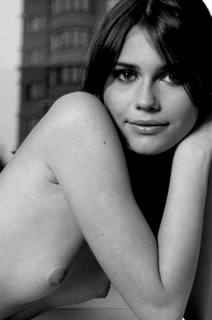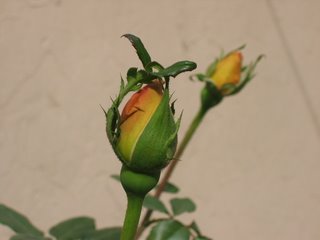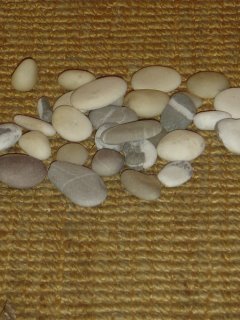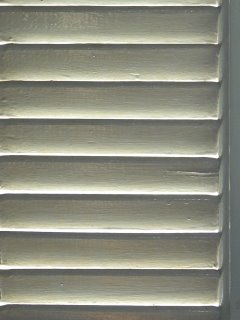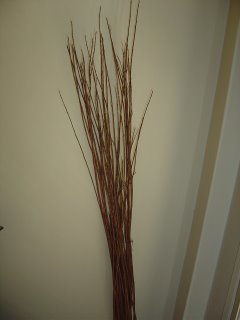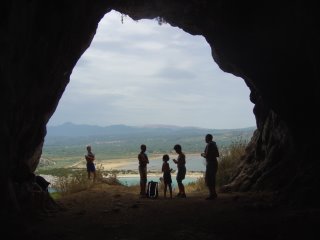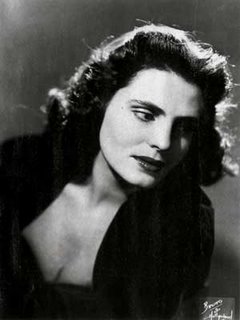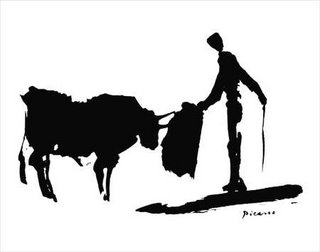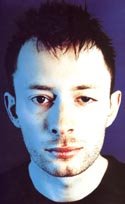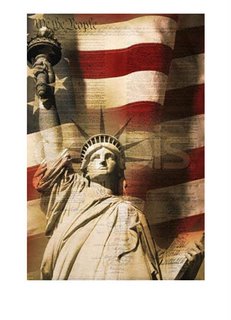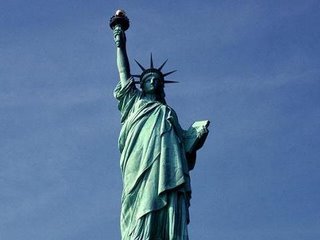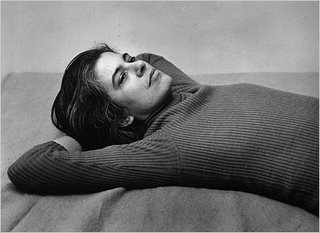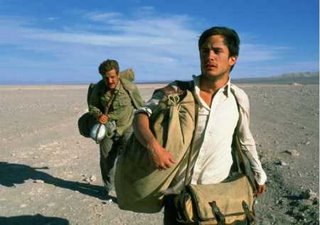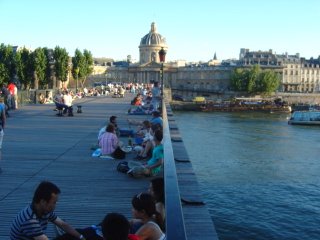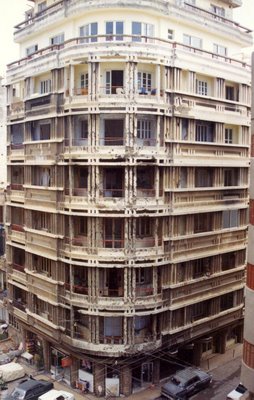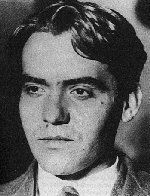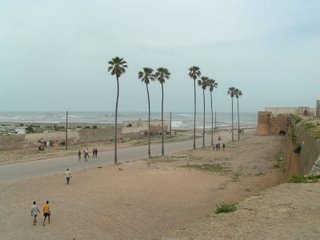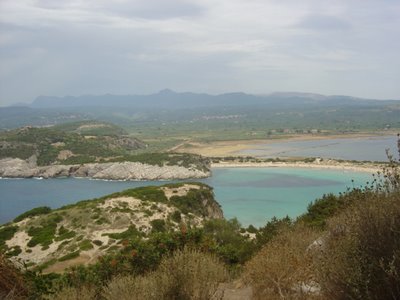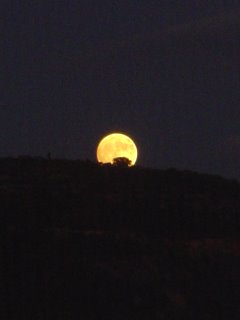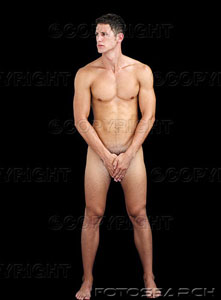
Thursday, August 31, 2006
Wednesday, August 30, 2006
Naguib Mahfouz, First Writer in Arabic to Win Nobel Prize, Dies at 94
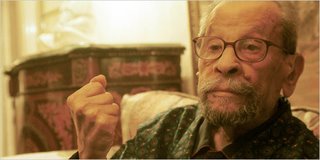
"Naguib Mahfouz, the Egyptian playwright and screenwriter who won the 1988 Nobel Prize in Literature and was widely regarded as the Arab world’s foremost novelist, died today, Reuters and The Associated Press reported. He was 94.Mr. Mahfouz had been hospitalized and in declining health since suffering a head injury in a fall at his home in July, the agencies reported, citing Dr. Hossam Mowafi, who supervised Mr. Mahfouz’s treatment and who announced his death.
Mr. Mahfouz’s city was teeming Cairo, and his characters were its most ordinary people: civil servants and bureaucrats, grocers, shopkeepers, poor retirees, petty thieves and prostitutes, peasants and women brutalized by tradition, a people caught in the upheavals of a nation struggling through the 20th century.
Around their tangled lives, Mr. Mahfouz chronicled the development of modern Egypt, and over five decades wrote 33 novels, 13 anthologies of short stories, several plays and 30 screenplays. It was a body of work hailed by the Swedish Academy of Letters as “an Arabian narrative art that applies to all mankind.”
Mr. Mahfouz, a slender, modest, shy man who once described himself as “a fourth- or fifth-class writer,” was often called the Egyptian Balzac for his vivid frescoes of Cairenes and their social, political and religious dilemmas. Critics compared his richly detailed Cairo with the London of Charles Dickens, the Paris of Émile Zola and the St. Petersburg of Fyodor Dostoyevsky.
He was the first Arab writer to receive the Nobel Prize, and while many of his works had been translated into French, Swedish and German, he was largely unknown in the United States and Europe in 1988. Only about a dozen Mahfouz books had been rendered into English, and many were out of print".
From "The New York Times"
Tuesday, August 29, 2006
Monday, August 28, 2006
Sunday, August 27, 2006
Saturday, August 26, 2006
NICOLAS BOURRIAUD

BOURRIAUD - RELATIONAL AESTHETICS - GLOSSARY
(INTEGRAL)
From "Relational Aesthetics" by NB, published by "les
Presses du Reel", Dijon, France
2002 english version 1998 french version.
it costs 11 or 12 euros... Deeply recommended.
Academism:
1. An attitude that involves clinging to the defunct signs and forms of one's day and rendering these aesthetic.
2. synonum: pompous (pompier)
-And why wouldn`t he do something pompous, if it pays off` (Samuel Beckett)
Aesthetics
An idea that sets humankind apart from other animal species. In the end of the day, burying the dead, laughter, and suicide are just the corollaries of a deep-seated hunch, that life is an aesthetic, ritualised, shaped form.
Art.
1. General term describing a set of objects presented as part of a narrative known as art history.This narrative draws up the critical genealogy and discusses the issues raised by these objects, by way of three sub-sets: painting,sculpture, architecture.
2. Nowadays, the word 'art' seems to be no more than a semantic leftover of this narrative, whose more accurate definition would read as follows: Art is an activity consisting in producing relationships with the world with the help of signs, forms, actions and objects.
Art (The end of )
'The end of art' only exists in an idealistic view of history. We can nevertheless, and not without irony, borrow Hegel`s formula whereby 'art, for us, is a thing of the past' and turn it into a figure of style: let us remain open to what is happening in the present, which invariably exceeds, a priori, our capacities of understanding.
Artist
When Benjamin Buchloh referred to the conceptual and minimal generation of the 1960`s, he defined the artist as a 'scholar-philosopher-craftsman' who hands society 'the objective results of his labour' . For Buchloh, this figure was heir to that of the artist as 'mediumic and transcendental subject' represented by Yves Klein, Lucio Fontana and Joseph Beuys. Recent developments in art merely modify Buchloh's hunch. Today's artist appears as an operator of signs, modelling production structures so as to provide significant doubles. An entrepeneur/politician/director. The most common denominator shared by all artists is that they show something. The act of showing suffices to define the artist, be it a representation or a designation.
Behaviour
1. Beside those two established genres, the history of things and the history of forms, we still need to come up with a history of artistic behaviours. It would be naive to think that the history of art represents a whole capable of perennially replacing these three sub-groups. An artist's microbiography would point up the things he has achieved within his oeuvre.
2. Artist, producer of time.
All totalitarian ideologies show a distinctive wish to control the time in which they exist. They replace the versatility of time invented by the individual by the fantasy of a central place where it might be possible to acquire the overall meaning of society. Totalitarianism systematically tries to set up a form of temporal motionlessness, and rendering the time in which it exits uniform and collective, a fantasy of eternity aimed first and foremost at standardising and monitoring patterns of behaviours. Foucault thus rightly stressed the fact that the art of living classed with 'all forms of fascism, be they already there or lurking '
Co-existence criterion
All works of art produce a model of sociability, which transposes reality or might be conveyed in it. So there is a question we are entitled to ask in front of any aesthetic production: 'Does this work permit me to enter into dialogue [ Could I exist, and how, in the space it defines?] A form is more or less democratic. May I simply remind you, for the record, that the forms produced by the art of totalitarian regimes are peremptory and closed in on themselves (particularly through their stress on symmetry).
Otherwise put, they do not give the viewer a chance to complement them.
(see: Relational (aesthetics)).
Context
In situ art is a form of artistic activity that encompasses the space in which it is on view. This consideration by the artist of the exhibition venue consisted, yesterday, in exploring its spatial and architectural configuration. A second possibility, prevalent in the art of the 1990s consists in an institutional structure, the socio-economic features encompassing it, and the people involved. This latter method calls for a great deal of subtlety : although such contextual studies have the merit of reminding us that the artistic doing does not drop out of the sky into a place unblemished by any ideology, it is nevertheless important to fit this investigation into a prospect that goes beyond the primary stage of sociology, It is not enough to extract, mechanically, the social characteristics of the place where you exhibit (the art centre, the city, the region, the country...) to ''reveal'' whatever it may be. For some artists who complicated thinking represents an architecture of meanings, no more nor less (Dan Asher, Daniel Buren, Jef Geys, Mark Dion) how many conceptual hacks are there who laboriously 'associate', for their show in Montelimar, nougat production and unemployment figures? The mistake lies in thinking that the sense of an aesthetic fact lies solely in the context.
2. Art after criticism
Once art 'overtook' philosophy (joseph Kosuth), it nowadays goes beyond critical philosophy, where conceptual art has helped to spread the viewpoint. Doubt can be cast over the stance of the 'critical' artist, when this position consists in judging the world as if he were excluded from it by divine grace, and played no part in it. This idealistic attitude can be contrasted with Lacanian intuition that the unconscious is its own analyst. And Marx's idea that explains that real criticism is the criticism of reality that exists through criticism itself. For there is no mental place where the artist might exclude himself from the world he represents.
Critical materialism
The world is made up of random encounters (Lucretius, Hobbes, Marx, Althusser). Art, too, is made of chaotic, chance meetings of signs and forms. Nowadays, it even creates spaces within which the encounter can occur. Present-day art does not present the outcome of a labour, it is the labour itself, or the labour-to-be.
Factitiousness
Art is not the world of suspended will (Schopenhauer), or of the disappearance of contingency (Sartre), but a space emptied of the factitious. It in no way clashes with authenticity (an absurd value where art is concerned) but replaces coherences, even phoney ones, with the illusory world of 'truth'. It is the bad lie that betrays the hack, who at best touching sincerity inevitably ends up as a forked tongue.
Form
Structural unity imitating a world. Artistic practice involves creating a form capable of "lasting", bringing heterogeneous units together on a coherent level, in order to create a relationship to the world.
Gesture
Movement of the body revealing a psychological state or designed to express an idea. Gesturality means the set of requisite operations introduced by the production of artworks, from their manufacture to the production of peripheral signs (actions, event, anecdotes)
Image
Making a work involves the invention of a process of presentation. In this kind of process, the image is an act.
Inhabiting
Having imagined architecture and art of the future, the artist is now proposing solutions for inhabiting them. The contemporary form of modernity is ecological,haunted by the occupancy of forms and the use of images.
Modern
The ideals of modernity have not vanished,they have been adapted. So "the total work of art" comes about today in its spectacular version, emptied of its teleological content. Our civilization makes up for the hyperspecialization of social functions by the progressive unity of leisure activities. It is thus possible to predict,without too much risk attaching thereto, that the aesthetic experience of the average late 20th century individual might roughly resemble what early 20th century avant-gardes imagined. Between the interactive video disk, the CD-Rom, ever more multi-media-oriented games consoles, and the extreme sophistication of mass recreational venues, discotheques and theme parks, we are heading towards the condensation of leisure in unifying forms. Towards a compact art. Once a CD-Rom and Cd-I drives are available. which have enough autonomy, books, exhibitions and films will be in competition with a form of expression that is at once more comprehensive and more thought-restricting, circulating writing, imagery and sound in new forms.
Operational realism
Presentation of the functional sphere in an aesthetic arrangement.The work proposes a functional model and not a maquette. In other words, the concept of dimension does not come into it, just as in the digital image whose proportions may vary dependng on the size of the screen, which unlike the frame, does not enclose works within a predetermined format, but rather renders virtuality material in x dimensions.
Ready-made
Artistic figure contemporary with the invention of film. The artist takes his camera-subjectivity into the real, defining himself as a cameraman: the museum plays the part of the film, he records. For the first time, with Duchamp, art no longer consists in translating the real with the help of signs, but in presenting this same real as it is (Duchamp, the Lumière brothers...
Relational Aesthetics
Aesthetic theory consisting in judging artworks on the basis of the inter-human relations which they represent, produce or prompt.(see co-existence criterion)
Relational (art)
A set of artistic practices which take as their theoretical and practical point of departure the whole of human relations and their social context, rather than an independent and private space.
Semionaut
The contemporary artist is a semionaut, he invents trajectories between signs.
Society of extras
The society of the spectacle has been defined by Guy Debord as the historical moment when merchandise achieved 'the total occupation of social life ' , capital having reached 'such a degree of accumulation' that it was turned into imagery. Today , we are in the further stage of spectacular development: the individual has shifted from a passive and purely repetitive status to the minimum activity dictated to him by market forces. So television consumption is shrinking in favour of video games, thus the spectacular hierarchy encourages 'empty monads', i.e. programmeless models and politicians, thus everyone sees themselves summoned to be famous for fifteen minutes, using a TV game, street poll or new item as go-between. This is the reign of the 'Infamous Man' , whom Michel Foucault defined as the anonymous and 'ordinary' individual suddenly put in the glare of the media spotlights. Here we are summoned to turn into extras of the spectacle, having been regarded as its consumers. This switch can be historically explained: since the surrender of the Soviet bloc, there are no obstacles on capitalism's path to empire.It has a total hold of the social arena, so it can permit itself to stir individuals to frolic about in the free and open spaces that it has staked out. So, after the consumer society, we can see the dawning of the society of extras where the individual develops as a part-time stand-in for freedom, signer and sealer of the public place.
Style
The movement of a work, its trajectory 'The style of a thought is its movement' (Gilles Deleuze and Félix Guattari).
Trailer
Having been an event per se (classical painting), then the graphic recording of an event (the work of Jackson Pollock with photographic documents describing a performance or an action), today's work of art often assumes the role of a trailer for a forthcoming event, or an event that is put off forever.
Friday, August 25, 2006
La Boheme: Charles Aznavour - Pour N.....
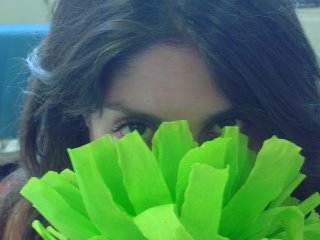
Je vous parle d'un temps
Que les moins de vingt ans
Ne peuvent pas connaître
Montmartre en ce temps-là
Accrochait ses lilas
Jusque sous nos fenêtres
Et si l'humble garni
Qui nous servait de nid
Ne payait pas de mine
C'est là qu'on s'est connu
Moi qui criait famine
Et toi qui posais nue
La bohème, la bohème
Ça voulait dire on est heureux
La bohème, la bohème
Nous ne mangions qu'un jour sur deux
Dans les cafés voisins
Nous étions quelques-uns
Qui attendions la gloire
Et bien que miséreux
Avec le ventre creux
Nous ne cessions d'y croire
Et quand quelque bistro
Contre un bon repas chaud
Nous prenait une toile
Nous récitions des vers
Groupés autour du poêle
En oubliant l'hiver
La bohème, la bohème
Ça voulait dire tu es jolie
La bohème, la bohème
Et nous avions tous du génie
Souvent il m'arrivait
Devant mon chevalet
De passer des nuits blanches
Retouchant le dessin
De la ligne d'un sein
Du galbe d'une hanche
Et ce n'est qu'au matin
Qu'on s'asseyait enfin
Devant un café-crème
Epuisés mais ravis
Fallait-il que l'on s'aime
Et qu'on aime la vie
La bohème, la bohème
Ça voulait dire on a vingt ans
La bohème, la bohème
Et nous vivions de l'air du temps
Quand au hasard des jours
Je m'en vais faire un tour
A mon ancienne adresse
Je ne reconnais plus
Ni les murs, ni les rues
Qui ont vu ma jeunesse
En haut d'un escalier
Je cherche l'atelier
Dont plus rien ne subsiste
Dans son nouveau décor
Montmartre semble triste
Et les lilas sont morts
La bohème, la bohème
On était jeunes, on était fous
La bohème, la bohème
Ça ne veut plus rien dire du tout
King of Pylos
Nestor (nes'tur) [key], in Greek mythology, wise king of Pylos; son of Neleus and father of Antilochus. In the Iliad, Nestor went with the Greeks to the Trojan War, and although he had lived three generations he was still a vigorous warrior and a respected adviser. In the Odyssey, because of his piety and prudence, the gods allowed him to return unharmed to Pylos after the war.
The Columbia Electronic Encyclopedia, 6th ed. Copyright © 2006, Columbia University Press. All rights reserved.
The Columbia Electronic Encyclopedia, 6th ed. Copyright © 2006, Columbia University Press. All rights reserved.
Thursday, August 24, 2006
Semiotics
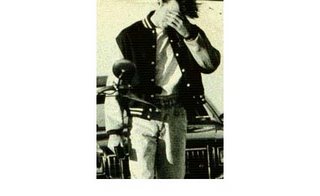
Here's a bit of an image from a magazine advertisement. Look at it. If you've never seen the image before, you're likely to wonder, "what's going on? why is the young man (you assume he's young because of his build, haircut, and dress) covering his face? Is he upset? What about?" Your mind, in other words, tries to understand this image as a moment in a sequence of events: as a story, a narrative (even though in reality this is just a model posing before a camera for an advertising shoot)
summertime Greece LOvE mE TeNdeR

Love me tender,
Love me sweet,
Never let me go.
You have made my life complete,
And I love you so.
Love me tender,
Love me true,
All my dreams fulfilled.
For my darlin I love you,
And I always will.
Love me tender,
Love me long,
Take me to your heart.
For its there that I belong,
And well never part.
Love me tender,
Love me dear,
Tell me you are mine.
Ill be yours through all the years,
Till the end of time.
(when at last my dreams come true
Darling this I know
Happiness will follow you
Everywhere you go).
Wednesday, August 23, 2006
Aranjuez mon amour
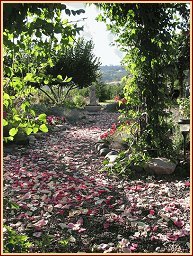
Mon amour, sur l'eau des fontaines, mon amour
Où le vent les amène, mon amour Le soir tombé, on voit flotter des pétales de roses
Mon amour, et les murs se gercent, mon amour Au soleil, au vent à l'averse et aux années qui vont passant Depuis le matin de mai qu'ils sont venus Et quand j'entend, soudain ils ont écrit sur les murs Du bout de leurs fusil de bien étranges choses
Mon amour le rosier suit les traces, mon amour Sur le mur, et enlace, mon amour, leur noms gravés Et chaque été d'un beau rouge sang, les roses
Mon amour, sèche les fontaines, mon amour Au soleil, au vent de la plaine et aux années qui vont passant Depuis le matin de mai qu' ils sont venus La fleur au cœur, les pieds nus le pas lent Et les yeux éclairés d'un étrange sourire
Et sur ce mur, lorsque le soir descend On croierait voir des tâches de sang Ce ne sont que des roses
Aranjuez, mon amour
ΣΑΝ ΑΕΡΑΚΙ
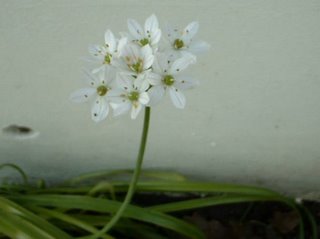
Χρυσή μου αγάπη, αν ήξερες, τι μέλι είσαι για μένα
Τα μπουμπουκάκια τα όμορφα, τα μοσχομυρισμένα
και τ' αεράκια που φυσούν, σαν λιποθυμισμένα
δεν έχουνε το βάλσαμο, που' χεις εσύ για μένα
Της λίμνης τα' αφρολούλουδα και του γιαλού η γαλήνη
η σμύρνα, το ροδόσταμο, που αργοσταλάει και σβήνει
κι οι ροδωνιές, κι η ολόδροση του κήπου ανθοπλημμύρα
των δυο χειλιών σου των γλυκών δεν στάζουνε τα μύρα
Πάω στην τρισέρημη αμμουδιά και μόνη, τι να κάνω
Χαράζω κύκλους απαλούς στη μουσκεμένη άμμο
Σαν αγεράκι χάνονται στο κύμα απάνω-απάνω
και απόμεινα στην ερημιά μονάχη, τι να κάμω
Τώρα το ετοιμοθάνατο, βαλσαμωμένο αγέρι
γλυκά τραγούδια θλιβερά ν' αναστενάξει ξέρει
Αλήθεια, ξέρει πιο γλυκά να τραγουδάει από μένα
Εγώ δεν ξέρω πιο γλυκά, μα ξέρω πιο θλιμμένα
Ναπολέων Λαπαθιώτης
Tuesday, August 22, 2006
TARZAN AND JANE

Oy yoy yoy yoy yoy yoy yay!...
Deep in the jungle,
in The Land Of Adventure, lives Tarzan
Oy yoy yoy yoy yoy yoy yay!...
I am tarzan from jungle, you can be my friend
Oy yoy yoy yoy yoy yoy yay!...
I am Jane, and I love to ride an elephant
My name is Tarzan, I am Jungle-man
The tree-top swinger from jungle-land
Come, baby come
I will take you for a swing
Let's go, honey, I'm tinkeling
Tarzan is handsome, Tarzan is strong
He's really cute, and his hair is long
Tarzan is handsome, Tarzan is strong
So listen to the jungle-song:
Oy yoy yoy yoy yoy yoy yay!...
I am Tarzan from jungle, you can be my friend
Oy yoy yoy yoy yoy yoy yay!...
I am Jane, and I love to ride an elephant
When you touch me, I feel funny
I feel it too, when you're touching me
Come to my tree-house to my party
Yes, I'll go if you carry me
Tarzan is handsome, full of surprise.
He's really cute, and his hair is nice
Tarzan is handsome, Tarzan is strong
So listen to the Jungle-song:
Oy yoy yoy yoy yoy yoy yay!...
I am Tarzan from jungle, you can be my friend
Oy yoy yoy yoy yoy yoy yay!...
I am Jane, and I love to ride an elephant
Go Cheetah, get banana
Hey monkey, get funky
When I am dancing, I feel funky
Monday, August 21, 2006
FRANCIS BACON

An illustrational form tells you through the intelligence immediately what the form is about, whereas a non-illustrational form works first upon sensation and then slowly leaks back into the fact.
The job of the artist is always to deepen the mystery.
I don’t think people are born artists; I think it comes from a mixture of your surroundings, the people you meet, and luck.
I paint for myself. I don’t know how to do anything else, anyway. Also I have to earn my living, and occupy myself.
I need the city; I need to know there are people around me strolling, arguing, fucking—living, and yet I go out very rarely; I stay here in my cage.
I should have been, I don’t know, a con-man, a robber or a prostitute. But it was vanity that made me choose painting, vanity and chance.
All artists are vain, they long to be recognised and to leave something to posterity. They want to be loved, and at the same time they want to be free. But nobody is free.
Some artists leave remarkable things which, a 100 years later, don’t work at all. I have left my mark; my work is hung in museums, but maybe one day the Tate Gallery or the other museums will banish me to the cellar…you never know.
Painting gave meaning to my life which without it it would not have had.
Picasso is the reason why I paint. He is the father figure, who gave me the wish to paint.
Picasso was the first person to produce figurative paintings which overturned the rules of appearance; he suggested appearance without using the usual codes, without respecting the representational truth of form, but using a breath of irrationality instead, to make representation stronger and more direct; so that form could pass directly from the eye to the stomach without going through the brain.
Picasso was one of that genius caste which includes Rembrandt, Michelangelo, Van Gogh and above all Velázquez.
Velázquez found the perfect balance between the ideal illustration which he was required to produce, and the overwhelming emotion he aroused in the spectator.+ Images also help me find and realise ideas. I look at hundreds of very different, contrasting images and I pinch details from them, rather like people who eat from other people’s plates.
Before I start painting I have a slightly ambiguous feeling: happiness is a special excitement because unhappiness is always possible a moment later.
You could say that I have no inspiration, that I only need to paint.
The creative process is a cocktail of instinct, skill, culture and a highly creative feverishness. It is not like a drug; it is a particular state when everything happens very quickly, a mixture of consciousness and unconsciousness, of fear and pleasure; it’s a little like making love, the physical act of love.
It (painting) can be as violent as fucking, like an orgasm or an ejaculation. The result is often disappointing, but the process is highly exciting.
My painting is not violent; it’s life that is violent.
Even within the most beautiful landscape, in the trees, under the leaves the insects are eating each other; violence is a part of life.
My painting is a representation of life, my own life above all, which has been very difficult. So perhaps my painting is very violent, but this is natural to me.
I have been lucky enough to be able to live on my obsession. This is my only success.
I have no moral lesson to preach, nor any advice to give.
Flesh and meat are life! If I paint red meat as I paint bodies it is just because I find it very beautiful.
Ham, pigs, tongues, sides of beef seen in the butcher’s window, all that death, I find it very beautiful. And it’s all for sale—how unbelievably surrealistic!
I often imagine that the accident that made man into the animal he has become also happened to other animals—lions or hyenas for example—while man remained a primate. What would have happened? It’s bizarre, I have never read anything about it, by Darwin or anyone else. Perhaps it’s science fiction, but it’s very interesting. I imagine men hanging in butcher’s shops for hyenas, who would be dressed in fur coats. The men would be hung by their feet, or cut up for stew or kebabs.
We are born with a scream; we come into life with a scream, and maybe love is a mosquito net between the fear of living and the fear of death.
The men I painted were all in extreme situations, and the scream is a transcription of their pain.
This is the artist’s privilege—to be ageless.When I paint I am ageless, I just have the pleasure or the difficulty of painting.
Sunday, August 20, 2006
LUCIAN FREUD
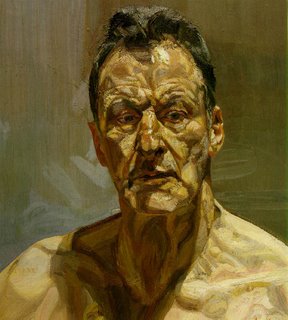
Reflection (self Portrait) 1985- oil on vanvas 52.2x51.2 cm
Private Collection
"Freud Quotes
The longer you look at an object, the more abstract it becomes, and, ironically, the more real.
I am only interested in painting the actual person, in doing a painting of them, not in using them to some ulterior end of art. For me, to use someone doing something not native to them would be wrong.
I remember Francis Bacon would say that he felt he was giving art what he thought it previously lacked. With me, it's what Yeats called the fascination with what's difficult. I'm only trying to do what I can't do.
I have a hatred of habit and routine. And what dogs love is just that. They like regular everything, and I don't have regular anything. I have a timetable, but no routine.
My work is purely autobiographical.. It is about myself and my surroundings. I work from people that interest me and that I care about, in rooms that I know.
When I look at a body it gives me choice of what to put in a painting, what will suit me and what won't. There is a distinction between fact and truth. Truth has an element of revelation about it. If something is true, it does more than strike one as merely being so.
THERE IS NO TIME TO ANALYZE: THOM YORKE
YMCA -- Old Skool
| A German talk show host does a parody of YMCA using old Hitler footage. Its.. Pretty funny. | |
Saturday, August 19, 2006
VOICES

Loved, idealized voices
of those who have died, or of those
lost for us like the dead.
Sometimes they speak to us in dreams;
sometimes deep in thought the mind hears them.
And, with their sound, for a moment return
sounds from our life's first poetry -
like distant music fading away at night.
Constantine P.Cavafy
Friday, August 18, 2006
Susan in the sky with diamonds
Thursday, August 17, 2006
WILLIAM BLAKE
 THE ANGEL
THE ANGELI dreamt a dream! What can it mean?
And that I was a maiden Queen
Guarded by an Angel mild:
Witless woe was ne'er beguiled!
And I wept both night and day,
And he wiped my tears away;
And I wept both day and night,
And hid from him my heart's delight.
So he took his wings, and fled;
Then the morn blushed rosy red.
I dried my tears, and armed my fears
With ten-thousand shields and spears.
Soon my Angel came again;
I was armed, he came in vain;
For the time of youth was fled,
And grey hairs were on my head.
ΕΚΟΜΙΣΑ ΕΙΣ ΤΗΝ ΤΕΧΝΗΝ
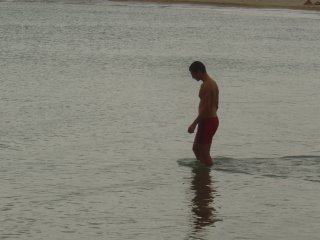
Κάθομαι και ρεμβάζω. Επιθυμίες κ’ αισθήσεις εκόμισα εις την Τέχνην — κάτι μισοειδωμένα,πρόσωπα ή γραμμές· ερώτων ατελών κάτι αβέβαιες μνήμες. Aς αφεθώ σ’ αυτήν. Ξέρει να σχηματίσει Μορφήν της Καλλονής·σχεδόν ανεπαισθήτως τον βίον συμπληρούσα, συνδυάζουσα εντυπώσεις, συνδυάζουσα τες μέρες.
Kωνσταντίνος Καβάφης
Θάλασσα του Πρωιού
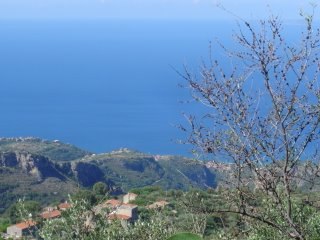
Εδώ ας σταθώ.
Κι ας δω κ’ εγώ την φύσι λίγο.
Θάλασσας του πρωιού κι ανέφελου ουρανού λαμπρά μαβιά, και κίτρινη όχθη·
όλα ωραία και μεγάλα φωτισμένα.
Εδώ ας σταθώ. Κι ας γελασθώ πως βλέπω αυτά (ταείδ’ αλήθεια μια στιγμή σαν πρωτοστάθηκα)·κι όχι κ’ εδώ τες φαντασίες μου,τες αναμνήσεις μου, τα ινδάλματα της ηδονής.
Kωντσταντίνος Καβάφης
Kωντσταντίνος Καβάφης
Wednesday, August 16, 2006
Federico Garcia Lorca
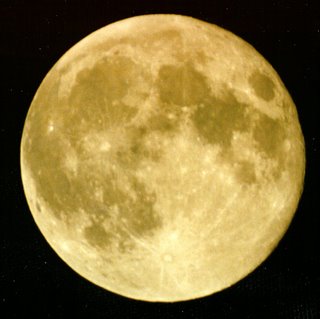
translated by Will Kirkland
The moon came into the forge
in her bustle of flowering nard.
The little boy stares at her, stares.
The boy is staring hard.
In the shaken air
the moon moves her amrs,
and shows lubricious and pure,
her breasts of hard tin.
"Moon, moon, moon, run!
If the gypsies come,
they will use your heart
to make white necklaces and rings."
"Let me dance, my little one.
When the gypsies come,
they'll find you on the anvil
with your lively eyes closed tight.
"Moon, moon, moon, run!
I can feelheir horses come."
"Let me be, my little one,
don't step on me, all starched and white!"
Closer comes the the horseman,
drumming on the plain.
The boy is in the forge;
his eyes are closed.
Through the olive grove
come the gypsies, dream and bronze,
their heads held high,
their hooded eyes.
Oh, how the night owl calls,
calling, calling from its tree!
The moon is climbing through the sky
with the child by the hand.
They are crying in the forge,
all the gypsies, shouting, crying.
The air is veiwing all, views all.
The air is at the viewing.
Federico García Lorca
Subscribe to:
Posts (Atom)
